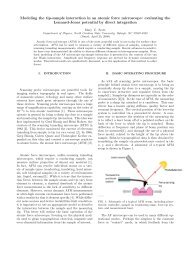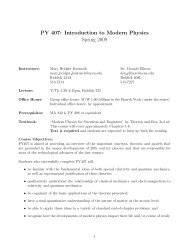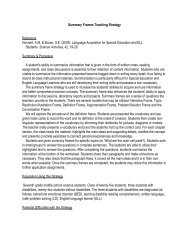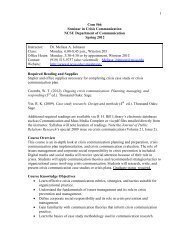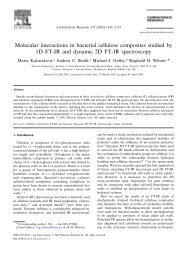Gorilla Warfare
Gorilla Warfare
Gorilla Warfare
Create successful ePaper yourself
Turn your PDF publications into a flip-book with our unique Google optimized e-Paper software.
..nternational<br />
BY SHARON BEGLEY<br />
N THE LUSH PLAINS OF CONGO'S VIRUNGA NATIONAL PARK LAST WEEK,<br />
the convoy ofporters rounded the final hill and trooped into camp.<br />
Theygently set down the wooden frame they had carried for miles,<br />
and with itthe very symbol oftheMricanjungle: a 600-pound silverback<br />
mountain gorilla. A leader ofa troop often visited by<br />
tourists, his arms and legs were lashed to the wood, his head hanging low and<br />
spots ofblood speckling his fur. The barefoot porters, shirts torn and pants<br />
caked with dustfrom their trek, lay him beside three smaller gorillas, all females,<br />
who had also been killed, then silently formed a semicircle around the<br />
bodies. As the stench ofdeath wafted across the camp in the waning afternoon<br />
light, a parkwarden stepped forward. "What man would do this?" he thundered.<br />
He answered himself: "Not even a beastwould do this:'<br />
Park rangers don't know who killed the four mountain gorillas<br />
found shot to death in Virunga, but it was the seventh killing of<br />
the critically endangered primates in two months. Authorities<br />
doubt the killers are poachers, since the gorillas' bodies were left<br />
behind and an infant-who could bring thousands ofdollars from<br />
a collector-was found clinging to its dead mother in one ofthe<br />
earlier murders. The brutality and senselessness ofthe crime had<br />
conservation experts concerned that the most dangerous animal<br />
in the world had found yet another excuse to slaughter the creatures<br />
with whom we share the planet. "This area mustbe immediately<br />
secured:' said Deo Kujirakwinja of the Wildlife Conservation<br />
Society's Congo Program, "or we stand to lose an entire<br />
population ofthese endangered animals."<br />
Back when the Amazon was aflame and the forests ofSoutheast<br />
Asia were being systematically clear-cut, biologists were<br />
clear about what posed the greatest threat to the world's wildlife,<br />
and it wasn't men with guns. For decades, the chief threat was<br />
habitat destruction. Whether it was from impoverished locals<br />
burning a forest to raise cattle or a multinational denuding a<br />
tree-covered Malaysian hillside, wildlife was dying because<br />
species were being driven from their homes. Yes, poachers<br />
killed tigers and other trophy animals-as they had since<br />
before Theodore Roosevelt-and subsistence hunters<br />
took monkeys for bushmeat to put on their tables, butthey<br />
were not a primary danger.<br />
That has changed. "Hunting, especially in Central and West<br />
Africa, is much more serious than we imagined:' says Russell Mitte~eier,<br />
president of Conservation International. "It's huge:'<br />
with the result that hunting now constitutes the pre-eminent<br />
threat to some species. That threat has been escalating over the<br />
past decade largely because the opening offorests to logging and<br />
mining means that roads connect once impenetrable places to<br />
towns. "It's easier to get to where the wildlife is and then to have<br />
access to markets:' says conservation biologist Elizabeth Bennett<br />
ofthe Wll.dlife Conservation Society. Economic forces are also at<br />
play. Thanks to globalization, meat, fur, skins and other animal<br />
parts "are sold on an increasingly massive scale across the world:'<br />
she says. Smoked monkey carcasses travel from Ghana to New<br />
York and London, while gourmets in Hanoi and Guangzhou feast<br />
on turtles and pangolins (scaly anteaters) from Indonesia. There<br />
is a thriving market for bushmeat among immigrants in Paris,<br />
New York, Montreal, Chicago and other points in the African di-<br />
22 NEWSWEEK AUGUST 6, 2007
aspora, with an estimated 13,000 pounds ofbushmeat-much of<br />
it primates-arriving every month in seven European and North<br />
American cities alone. "Hunting and trade have already resulted<br />
in widespread local extinctions in Asia and West Africa;' says<br />
Bennett. "Theworld's wild places are falling silent:'<br />
When a company wins a logging or mining concession, it immediately<br />
builds roads wide enough for massive trucks where the<br />
principal access routes had been dirt paths no wider than a jaguar.<br />
"Almost no tropical forests remain across Africa and Asia which<br />
are not penetrated by logging or other roads;' says Bennett.<br />
Hunters and weapons follow, she notes, "and wildlife flows cheaply<br />
and rapidly down to distant towns where it is either sold directly<br />
or links in to global markets." How quickly can opening a forest<br />
ravage the resident wildlife? Three weeks after a logging company<br />
opened up one Congo forest, the density ofanimals fell more than<br />
25 percent; a year after a logging road went into forest areas in<br />
Sarawak, Malaysia, in 2001, not a single large mammal remained.<br />
A big reason why hunting used to pale next to habitat destruction<br />
is that as recently as the 1990s animals were killed mostly for<br />
subsistence, with locals taking orily what they needed to live.<br />
Governments and conservation groups helped reduce even that<br />
through innovative programs giving locals an economic stake in<br />
the preservation of forests and the survival of wildlife. In the<br />
mountains ofRwanda, for instance, tourists pay $500 to spend<br />
an hour with the majestic mountain gorillas, bolstering the economy<br />
ofthe surrounding region. But recent years have brought a<br />
more dangerous kind of hunter, and not only because they use<br />
AK-47s and even land mines to hunt.<br />
The problem now is that hunting, even ofsupposedly protected<br />
animals, is a global, multimillion-dollar business. Eating<br />
bushmeat "is now a status symbol;' says Thomas Brooks ofConservation<br />
International. "It's not a subsistence issue. It's not a<br />
poverty issue. It's considered supersexy to eat bushmeat." Exact<br />
figures are hard to come by, but what conservation groups know<br />
about is sobering. Every year a single province in Laos exports<br />
$3.6 million worth of wildlife, including pangolins, cats, bears<br />
and primates. In Sumatra, about 51 tigers were killed each year<br />
between 1998 and 2002; there are currently an estimated 350<br />
tigers left on the island (down from 1,000 or so in the 1980s) and<br />
fewer than 5,000 in the world.<br />
Ifa wild population is large enough, it can withstand hunting.<br />
Butfor many species that "if" has not existed for decades. As a result,<br />
hunting in Kilum-Ijim, Cameroon, has pushed local elephants,<br />
buffalo, bushbuck, chimpanzees, leopards and lions to<br />
the brink of extinction. The common hippopotamus, which in<br />
1996 was classified as of "least concern" because its numbers<br />
seemed to be healthy, is now "vulnerable": over the past 10 years<br />
its numbers have fallen as much as 20 percent, largely because the<br />
hippos are illegally hunted for meat and ivory. Pygmy hippos,<br />
classified as "vulnerable" in 2000, by lastyear had become endangered,<br />
at risk of going extinct. Logging has allowed bushmeat<br />
hunters to reach the West African forests where the hippos live;<br />
fewer than 3,000 remain.<br />
Setting aside parks and other conservation areas is only as<br />
good as local enforcement. "Halfofthe major protected areas in<br />
Southeast Asia have lost at least one species of large mammal<br />
due to hunting, and most have lost many more;' says Bennett.<br />
In Thailand's Doi Inthanon and Doi Suthep National Parks, for<br />
instance, elephants, tigers and wild cattle have been hunted<br />
into oblivion, as has been every primate and hornbill in<br />
Sarawak's Kubah National Park. The world-famous Project<br />
Tiger site in India's Sariska National Park has no tigers, biologists<br />
announced in 2005. Governments cannot afford to pay as<br />
many rangers as are needed to patrol huge regions, and corruption<br />
is rife. The result is "empty-forest syndrome": majestic<br />
landscapes where flora and small fauna thrive, butwhere larger<br />
wildlife has been hunted out.<br />
Which is not to say the situation is hopeless. With governments<br />
and conservationists recognizing the extinction threat<br />
posed by logging and mining, they are taking steps to ensure that<br />
animals do not come out along with the wood and minerals. In<br />
one collaboration, the government ofCongo and the WCS work<br />
with a Swiss company, Congolaise Industrielle des<br />
Bois-which has a logging concession near Nouabale<br />
Ndoki National Park-to ensure that employees and<br />
their families hunt only for their own food needs; the<br />
company also makes sure that bushmeat does not get<br />
stowed away on logging trucks as illegal hunters try to take<br />
their haul to market. Despite the logging, gorillas, chimps,<br />
forest elephants and bongos are thriving in the park.<br />
Anyone who thrills at the sight ofman'S distant cousins<br />
staring silently through the bush can only hope thatthe executions<br />
ofVirunga's gorillas is an aberration. At the end of the<br />
week, UNESCO announced that it was sending a team to investigate<br />
the slaughter.<br />
With SCOTT JOHNSON in Virunga Park and JULIE SCElFO in New York<br />
AUGUST 6. 2007 NEWSWEEK 23
BY SCOTT JOHNSON<br />
THE MEN HUDDLED UNDER<br />
billowinggreen ponchos<br />
and shouldered their<br />
AK-47s nervously. Summer<br />
rains drenched the plains<br />
and canopiedjungle ofVirunga<br />
National Park, a vast preserve<br />
along the eastern borderofthe<br />
Democratic Republic ofCongo<br />
thatis home to an estimated 60<br />
percentoftheworld's surviving<br />
mountain gorillas. The men allowed<br />
the rain to douse their<br />
cigarettes. Then, in single file,<br />
theybegan to move into the<br />
forest. Through the din ofthe<br />
storm, a shout quickly rose up.<br />
The rangers found the first corpse less than a hundred<br />
yards away, in a grove ofvines and crooked<br />
thicket The mammoth gorilla lay on her side, a<br />
small pink tongue protruding slightly from her<br />
lips. She was pregnant and her breasts were engorged<br />
with milk for the baby that now lay dead inside<br />
her womb.<br />
The rangers crowded around and caressed the<br />
gorilla's singed fur. They shook their heads and<br />
clicked their tongues with disapproval. One<br />
grabbed her hand and held it for a long time, his<br />
head bowed in grief This gorilla-whom the<br />
rangers knew as intimately as they do all those who<br />
live in their sector of the park-was named Mburanumwe.<br />
Her killers had set her alight after executing<br />
her. Now her eyes were closed, as ifin deep<br />
concentration. "My God;' one ranger said in disgust,<br />
"they even burned her." Nearby the rangers<br />
found the bodies of two other adult females, all<br />
from the same 12-member family. 1\vo infants had<br />
been orphaned. A male would be found dead the<br />
next day. The massacre, first discovered onJuly 23,<br />
could be the worst slaughter of mountain gorillas<br />
in the last quarter century.<br />
Even the rangers-who live in a country where<br />
more than 4 million people may have been killed in
have traditionally begun, the fighting continues<br />
to rage.<br />
Hutu extremists who retreated to the<br />
park after their massacre of Rwandan<br />
Thtsis back in 1994 have settled along its<br />
edges; three years ago some 8,000 Rwandans<br />
crossed the border into Virunga<br />
looking for pastoral land, and mowed<br />
down more than 3,000 acres ofprime gorilla<br />
habitat in less than three weeks. Earlier<br />
this year Thtsi forces loyal to a renegade<br />
Congolese general also moved into<br />
the park, which houses not only one of<br />
the world's most remarkable collections<br />
of biodiversity but gold, coltan, zinc and<br />
valuable timber. According to local human-rights<br />
workers and renowned palen.n:t:,-,,]n~c.*:<br />
n;~:ho.:t"A T-A.a.'kA:U ft"Iont:r nt:ho....
a corrupt mafia of charcoal merchants<br />
has recently begun harvesting Virunga's<br />
forests to fuel a $30 million-a-year industry.<br />
"These are their oil wells," Leakey<br />
says ofVirunga's trees. Ifunchecked, the<br />
loggers' activities could decimate the gorilla<br />
habitat in a few years.<br />
The mountain gorillas, partofa worldwide<br />
population that numbers around<br />
700, have become more-direct targets as<br />
well. Seven have been killed, some would<br />
say murdered, since January. They have<br />
not been killed for their meat or their pelts<br />
or their internal organs. In fact, no one is<br />
quite sure why they've been killed. InJanuary<br />
two of them died amid fighting between<br />
the renegade general, Laurent<br />
Nkunda, and government forces. But others,<br />
like the family found last week, have<br />
been shot at close range and in some cases<br />
mutilated.<br />
One of the rangers, Paulin Ngobobo,<br />
43, has been intimately involved in trying<br />
to stop the charcoal trade from spreading<br />
across Vrrunga. A devout Christian, with a<br />
wry sense of humor, Ngobobo is fiercely<br />
protective of the gorillas in his sector of<br />
the park. Six months ago he was lecturing<br />
villagers about the threat the charcoal industry<br />
posed to Vuunga when men in military<br />
uniforms showed up, stripped him of<br />
his shirt and flogged him in front of the<br />
audience. Last month he posted a blog<br />
item in which he accused the charcoal<br />
merchants of being complicit in the destruction<br />
ofthe gorillas' habitat. Two days<br />
later unknown gunmen killed a female gorilla<br />
under his care.<br />
Ngobobo says he has received death<br />
threats and warnings to stop criticizing<br />
the charcoal industry. Then came last<br />
week's killings, which many in his unit<br />
have interpreted as political assassinations-a<br />
message from the powerful interests<br />
that operate in the area. "There are<br />
people who are feeding off this conflict:'<br />
Ngobobo warns darkly. Last week authorities<br />
arrested Ngobobo and accused<br />
him of negligence because the recent<br />
killings all happened on his watch; his<br />
supporters claim that that was part ofthe<br />
assassins' plan all along. Ngobobo denies<br />
any wrongdoing.<br />
Rangers like Ngobobo are certainly not<br />
the ones profiting in Vrrunga. Some 600 of<br />
them patrol the vast park, the oldest in<br />
28 NEWSWEEK AUGUST 6. 2007
Africa. Yet most have not received their<br />
government salaries in years. Instead<br />
many are now paid by a European Unionfunded<br />
conservation group called Wildlife<br />
Direct, cofounded in January by Leakey.<br />
The group solicits funds from donors with<br />
the guarantee that 100 percent ofthe money<br />
goes straight to the rangers.<br />
Those officers are devoted to their imposing<br />
charges. They have their favorites,<br />
whom they follow closely and write about<br />
on a blog that Wildlife Direct has set up.<br />
Leakey's partner, Emmanuel de Merode,<br />
says thatas recently as 2001 "therewasn't a<br />
single vehicle in the whole sector; none of<br />
the rangers had uniforms or rifles!' Since<br />
1994, about 120 rangers have been killed<br />
in the line of duty. Even now they are<br />
hopelessly outgunned: Nkunda alone has<br />
almost 8,000 highly trained men under his<br />
command. Last week the United Nations,<br />
which has several thousand peacekeepers<br />
stationed in the area, declared Nkunda's<br />
forces "the single most serious threat" to<br />
Congolese stability. "It's almost impossible<br />
to be sanguine about the gorillas' future,"<br />
says Leakey. "They are hugely vulnerable<br />
in part because they're living in areas that<br />
are hugely unsettled ... The security ofthis<br />
species is not guaranteed."<br />
The morning after last week's massacre,<br />
whenthe rains hadstopped, rangers<br />
returned to the forests to search for survivors.<br />
That's when they discovered the<br />
hulking mass ofSenkekwe, a 600-pound<br />
silverback shot execution style in a copse<br />
oflush vegetation. One massive arm was<br />
outstretched, the other held close to his<br />
heart, perhaps a sign that he died while<br />
thumpinghis chest. With Senkekwegone,<br />
the unity of the family was immediately<br />
cast in doubt.<br />
As the sun cleared the valley walls and<br />
rose into the sky, nearly a hundredvillagers<br />
from nearby settlements gathered on the<br />
slopes below the forest. They carried the<br />
powerful bodies out and laid them reverently<br />
on the ground. They carefully<br />
wrapped the great apes' faces with leaves to<br />
keep flies away. Using trees and stalks of<br />
cut bamboo, they lashed the dead gorillas<br />
to makeshift stretchers. And then, with a<br />
mighty surge and a great clattering of<br />
voices, they hoisted the gorillas onto their<br />
shoulders and marched down the hills, toward<br />
the setting sun.<br />
•<br />
AUGUST 6, 2007 NEWSWEEK 29



